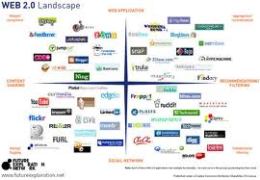Activity 1 – Introduction
1) What do you think are the key aspects of Web 2.0 that are likely to impact on education in today’s schools?
- it’s a shared technology
- students can create information and be active participants in their learning – supports GI and constructivism
- change the learning environment from one that is static and teacher-led to one that is dynamic and engaging – democratic
- suits individual learning styles
2) What are the opportunities here for teacher librarians?
- engage students with tools that they would use anyway
- utlilise current technology
- create online materials that students can access anywhere and at anytime
- share programs and resources
- share student work with teachers who need convincing that this is the way to go!
- interactive learning opportunities for the students
3) Can teacher librarians afford to ignore Web 2.0 tools?
No! However, part of me would like to ignore it because there’s so much there and I don’t know where to start!!
Activity 2 – Blogs
I am so excited by the prospect of creating a blog for the school library – I’ve had a look at a number in NSW public schools and love how they share the student’s work with the parents. As a parent, I’m often asking my children what they have done at school and this is a fantastic way to share. Some other positives include:
- sharing resources with students and teachers
- creating a debate with older students on a topic
- having a library newsletter that shares photos and podcasts
Some issues would include ensuring privacy and having the time to update.
Activity 3 – Wikis
So, in my mind, wikis are more interactive for children to use than a blog? Some interesting things that I didn’t realise;
- simple websites that are created and edited by many authors
- can add new information
- can be public, protected or private
- easy to use, can upload almost anything
- has a searching and tagging function
- can create a discussion forum
- able to have an RSS feed
I might use one to:
- create and share stories
- create and share research projects
- communicate
- discuss issues
- have research tutorials or other tutorials to suit the needs of the children
Activity 4 – Social bookmarking
I like the idea that you can use Del.icio.us or diigo or sqworl to bookmark your references. This is an invaluable tool to use in the library as you can provide URLs to teachers and students in a user-friendly format. Can you imbed this resource into a wiki?
Bookmarking means that you can go back to these sites at a later date and that they can be retrieved from a different computer.
Possible limitations would be having to sign up to use them, limited access and time to create and use them.
Activity 5 – NZ video
It was so enlightening so see someone who started with only a limited amount of technological knowledge to progressing to where she is now. I was starting to feel overwhelmed, but she’s put it all in to perspective. I love the way she trialled the use first before launching it into the classroom. I was starting to think that I needed to create a library blog, a delicious site, etc. all at once – but it’s one stage at a time and it’s where the school is currently at.
Readings
- Hargadon’s article was great at comparing the different social bookmarking sites and explaining exactly what they all are!
- Web Tools for kids had some fun activities.
References
Edublogs (2008). 10 ways to use your edublog to teach. Retrieved July 4, 2012.
Hargadon, S. (2007). Best of social bookmarking. School Library Journal, 53(12), 20. Available CSU Library.
Hauser, J. (2007). Media specialists can learn Web 2.0 tools to make schools more cool. Computers in Libraries, 27(2), 47-48. Available CSU library.
Jove, A. & Perez, L. (2012). Web Tools for kids. Retrieved July 4, 2012.
Lamb, A., & Johnson, L. (2007). An information skills workout: Wikis and collaborative writing. Teacher Librarian, 34(5), 57-59. Available CSU Library.
O’Connell, J. and Groom, D. (2010) Connect, communicate, collaborate. ACER Press. This book is recommended for purchase at $19.95 from https://shop.acer.edu.au/acer-shop/product/A5075BK/35
O’Connell, J. (2006). Engaging the Google generation through Web 2.0: Part 1. Scan, 25(3), 46-50. Available CSU Library.
Valenza, J. (2011). New tools. Retrieved July 4, 2012.

